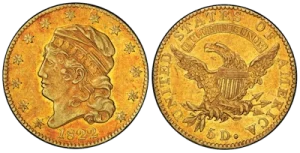
United States Coins
U.S. coins trace the story of a growing nation through metal, mintmarks, and meaning. From colonial coppers to mid-century silver, each piece reflects America’s spirit, craftsmanship, and evolving identity.
Early U.S. Coinage
The 1794 Flowing Hair Dollar marked a bold start to American coinage. Crafted in silver, these early designs symbolized independence and remain admired for their historical significance.
19th-Century Growth
As the U.S. Mint expanded, coins like the Large Cent became everyday essentials. These pieces offer tactile links to the industrial rise and cultural shifts of the 1800s.

Popular Types of U.S. Coins
Introduced in 1909, Lincoln Cents remain a cornerstone of American collecting. Varieties like the 1909-S VDB and the 1955 Doubled Die are celebrated for their design quirks and enduring appeal. Buffalo Nickels evoke the rugged West through bold imagery. Morgan Silver Dollars shimmer with Gilded Age artistry. And pre-1933 U.S. Gold Coins reflect eras of design and transformation.
Grading and Certification
Surface quality and wear help tell a coin’s story. Services like PCGS and NGC offer authentication and condition-based evaluations to support collector confidence. Certified coins offer clarity and consistency for collectors. Examples like Mint State Morgan Dollars are appreciated for their preservation and historical context.
??? Which U.S. coins are considered culturally iconic?
Coins like the 1933 Saint-Gaudens Double Eagle and the 1794 Flowing Hair Dollar are admired for their design, history, and role in shaping American numismatic traditions.
???Where can collectors learn about authenticated coinage?
Sites like Heritage Auctions and dedicated forums offer insights into grading trends and notable specimens. Always review sourcing and historical context when exploring rare issues.
From copper cents to gold eagles, U.S. coins carry stories that transcend currency. Their edges whisper of innovation, artistry, and a nation’s growth—one coin at a time.
How U.S. Coin Designs Reflect a Nation’s Story
Over time, the design and composition of U.S. coins have mirrored cultural shifts and historical milestones. These changes didn’t just reflect society — they helped shape its visual identity and shared memory.
Consider the 1909 Lincoln cent: the first U.S. coin to feature a real person. With Abraham Lincoln on the front and two wheat ears on the back, the design honored leadership and agricultural heritage — grounding currency in storytelling.
In 1932, the Washington quarter debuted to mark the bicentennial of George Washington’s birth. Its bold profile soon became one of the most familiar images in American pocket change, reinforcing historical reverence in everyday life.




 '
'